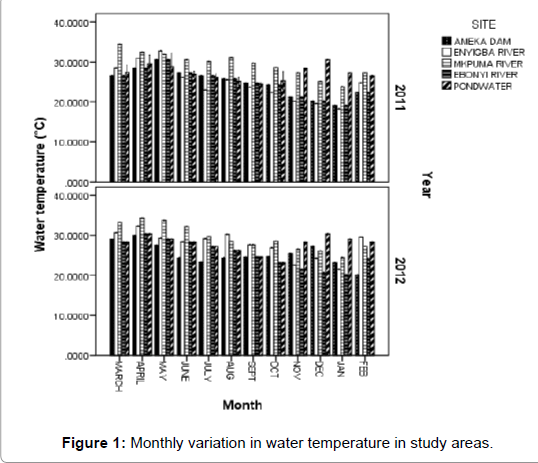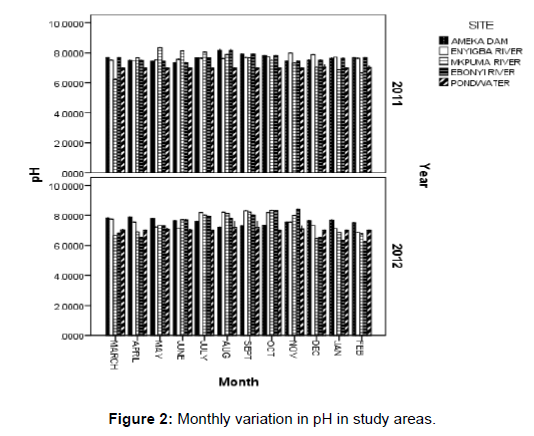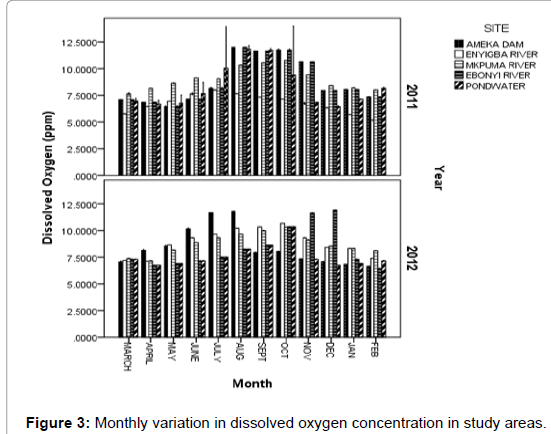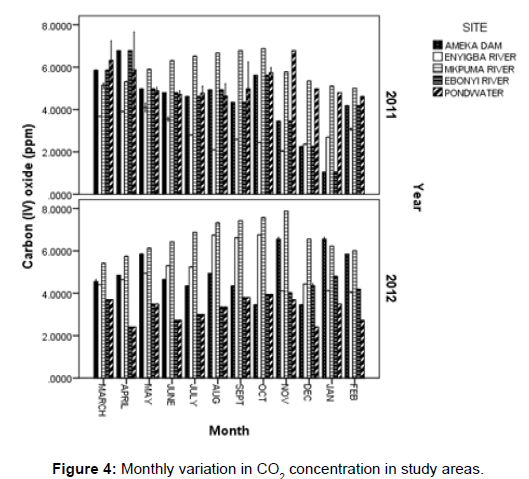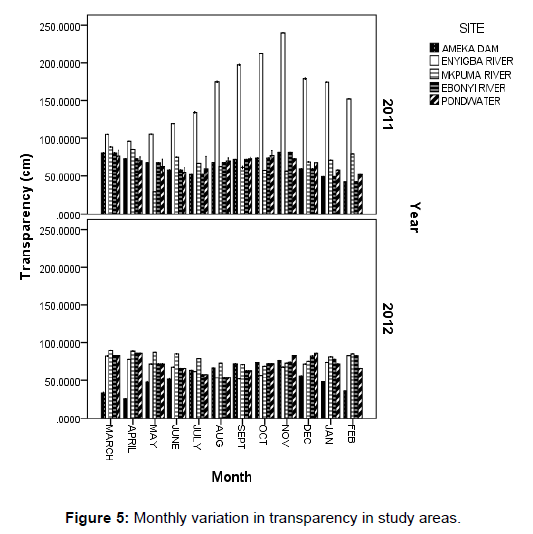Research Article Open Access
The Monthly Variation in Physiochemical Parameters of Ebonyi River System
Nwabunike MO*
Department of Fisheries and Aquaculture, Faculty of Agriculture and Natural Resource Management, Ebonyi State University, Nigeria
- Corresponding Author:
- Nwabunike MO
Department of Fisheries and Aquaculture
Faculty of Agriculture and Natural Resource Management
Ebonyi State University, Nigeria
Tel: +234 806 835 8468
E-mail: Evanmaur@gmail.com
Received date December 23, 2015; Accepted date April 14, 2016; Published date April 19, 2016
Citation: Nwabunike MO (2016) The Monthly Variation in Physiochemical Parameters of Ebonyi River System. J Fisheries Livest Prod 4:182. doi:10.4172/2332-2608.1000182
Copyright: © 2016 Nwabunike MO. This is an open-access article distributed under the terms of the Creative Commons Attribution License, which permits unrestricted use, distribution, and reproduction in any medium, provided the original author and source are credited.
Visit for more related articles at Journal of Fisheries & Livestock Production
Abstract
The study analyzed the monthly variation in physiochemical parameters of Ebonyi river system. The objectives of the study were to analyze the monthly physiochemical properties of Ebonyi river system and to make necessary recommendations for the general improvement of fish management in the study area. Stratified random sampling was carried out in each water body. The fishes were caught, identified, counted, graded, measured and weighed according to species. The species for chemical and histological analysis were taken immediately after weighing to the laboratory. Concentration of metals were studied in fish blood, liver and in the tissue lying between the lateral lines and the fins, since high concentrations of metals do not imply that the metal have a toxic effect (-). Toxicity of metals is mostly associated with vital physiological functions, such as enzyme activity, modifications in membrane, lipid composition and changes in tissue structures.
Keywords
Ebonyi; Oxygen; Aquatic animals; Pesticides; Mining effluents
Introduction
Fresh water is a finite resource, essential for agriculture, industry and even for human survival. Without fresh water of adequate quality and quantity sustainable development will not be possible. Because of this reason, governments of most countries see an imperative need to become involved in its over-all management. Yet in many developing countries, water resources are not being managed efficiently and in a manner that will sustain the natural qualities.
It was observed that in 2011, the monthly variation in water temperature showed that Mkpuma River consistently had higher water temperature except in April and December when higher water temperatures were recorded in Enyigba and Pond water, respectively. The water temperature in 2012 was still higher in Mkpume River in all months of sampling except in December, January and February; when higher water temperature were noted in pond water and Enyigba river (Figure 1). The pH of all study area at different months in 2011 was relatively the same except in May, June and July when pH of Mkpuma River was noticeably higher than those of other study areas. In 2012, in most months higher pH values were recorded in Enyigba River and Ameka Dam (Figure 2). Dissolved oxygen concentration was higher in Mkpuma river compared to those of other study areas in months of March, April, May and June in 2011. However, from July to November, higher dissolved oxygen concentrations were obtained from pond water, Enyigba river, Ameka Dam or Ebonyi river. Then towards the end of the study in 2011, higher dissolved oxygen was seen in Mkpuma River. In 2012, dissolved oxygen concentration was more in Ameka dam followed by Enyigba River from March to August. Very high dissolved oxygen concentrations were recorded in Ebonyi River in November and December (Figure 3). In March and April 2011, the CO2 concentrations of other study areas were higher than that of Mkpuma River but from May to February excluding November, higher CO2 readings were recorded in Mkpuma River. In 2012, Mkpuma River consistently had higher CO2 values this was followed by those of Enyigba River and Ameka Dam (Figure 4). The transparency of Enyigba River was markedly higher than those of other study areas in all through the sampling months in 2011 but in 2012, the transparency of this River dropped drastically. In 2012, the transparency of study areas was comparable (Figure 5). Similar observation was reported earlier by Pathiratne by monitoring the environmental influence on outbreak of EUS in fresh water fish. Based on the research findings, the following policy recommendations are therefore proffered. World health/bank should please assist the state Government in making available good quality refined urban tap water to the villages and subborbs so as to save the lives of both urban and Rural dwellers. Safe disposal of domestic wastes and control of industrial effluents should be practical and where possible recycled to avoid these metals and other contaminants from going into the environment. There should be periodic monitoring of the heavy metals concentration in both the fishes and river system to ensure continuous safety of people in the area.
Heavy metals are commonly found in natural waters and some are essential to living organisms, they may become highly toxic when present in certain concentrations. These metals also gain access into ecosystem through anthropogenic and get distributed in the water body, tended solids and sediments during the course of their mobility [1]. The rate of bioaccumulation of heavy metals in aquatic organisms depends on ability of the organisms to digest the metals in the river; it has to do with the concentration of the heavy metal in the surrounding soil sediments, and as well the feeding habits of the organism. Aquatic animals (including fish) bio-accumulate trace metals in considerable amounts and stay over a long period. Fishes have been recognized as a good accumulator of organic and inorganic pollutants [2]. Age of fish, lipid content in the tissue and mode of feeding are significant factors that affect the accumulation of heavy metals in fishes. Some heavy metals such as Zn and Fe are essential nutrients for animals and plants but are dangerous at high levels, whereas Pb have no well-defined physiological functions but are detrimental at certain limits [3]. At such concentration, it may cause neurological impairment and central nervous system malfunctioning. Fish diagnoses are often used to detect and monitor these heavy metal contaminations in aquatic ecosystem.
The surface drainage in the study area is irregular and consists of a number of small streams forming a dendritic pattern. The streams generally flow in different directions and empty into the Ebonyi River which is the main drainage channel serving the whole of Ebonyi State and it’s environ.
The river basin is a booming fish farming area during dry and rainy seasons. Most industrial activities in the area include: stone crushing, metal mining (Pb-Zn) and smelting. These are located less than 100 meters near the river and they discharge their wastes directly into the river. When fish bio-accumulates these pollutants, it becomes a threat to human health since consumers depend heavily in the fish for their dietary needs. In addition, the streams also which serves as both drinking and domestic water become undrinkable since it endangers human health directly or indirectly.
Research questions
The biodiversity of inland aquatic ecosystem is increasingly threatened by a variety of factors all of which are related to humans [4]. Available data suggest that 30% of fish species are threatened by human activities [5-10]. Metals such as mercury, cadmium, copper and zinc form major types of toxic compounds that are released into many water courses by the mining industry [2]. Both air emissions and wastewaters are sources of metal pollution.
Ebonyi State being naturally endowed with several mineral resources which range from lead, gypsum, calcium carbonate, copper, zinc, mercury, etc. is seen to be blessed by nature. These resources have as well attracted several investors in the area of mining. These miners are sole business men who are interested in their product without giving cognizance to the effect of or the by-product of their activity on their surrounding environment.
The Ebonyi river system is an example of the beautiful but vulnerable natural river system of the Federal Republic of Nigeria. Lack of fundamental information on the factors determining effect of quarrying activity on surrounding waters has made it imperative for such work. The chemicals used in the mining processes often escape into the environment causing large scale air and water pollution. It is pertinent to consider how mining affects its environment especially, land, water and the biodiversity.
Looking at the vast deposit of mineral resources in the state, miners have been attracted to the different locations of the state for economic purpose without considering its side effects. Meanwhile, metal pollution of Ebonyi river system caused by mining has not received any serious attention and the heavy metal contamination of its fishes has not been studied. Thus, this study investigated the effects of heavy metals on the aquatic systems and fisheries of Ebonyi river system.
In order to achieve the objectives of this study, the following research questions were asked: What are the monthly variations in physiochemical parameters of Ebonyi river system? What are the possible management practices to reduce this pollution of these rivers?
Objectives of the Study
The broad objective of the study is to determine the correlations of physicochemical parameters of Ebonyi river system.
The specific objectives are to find out:
1. The monthly variation in physiochemical parameters in the study area.
2. Make necessary recommendations for the general improvement of fish management in the study area.
Justification of the Study
Fish had long been regarded as a desirable and nutritional source of high quality protein with generous supply of minerals and vitamins. During the last few decades, great attention has been paid to the possible dangers of heavy metal poisoning in humans due to the consumption of contaminated fish. Industrial and agricultural discharges such as coal and oil combustion, phosphate fertilizers, plastics, pesticides and mining effluents are considered the major sources of heavy metal pollutants of water. Fishes that absorbed heavy metals are recognized for their detrimental effects on human health. Metals also, may act as allergens, mutagens or carcinogens [5]. Many investigators [6] have studied the presence of heavy metals in surface waters and in fish. Some authors investigated the removal of heavy metals from water [7]. Up till now, methods of removal of heavy metals and other pollutant have not been well investigated. The detection of toxicity of these pollutants in the water body and the aquatic organisms (fish) within this vicinity in recent times necessitated the study and this will attract the attention of various non-governmental organizations, donor agencies and researchers for possible intervention.
This study tends to be of maximum benefit to the farmers, residents, NGOs, miners, environmental policy makers, Ebonyi State Government, Researchers and the general public. The residents who use the water for drinking and domestic purposes (cooking) should access if the water is not good for the health without passing through treatment processes. This knowledge will now spur them into calling for Government assistance and in the area of drinking and domestic water for public use. The outcome of the study will be useful as a guide for NGOs workers especially those working on environmental issues and human health to see how they will call for foreign donors and WHO intervention on the behalf of the residents if need be.
Researchers will benefit from the study through consultation based on the work which will enable them go into further research which would be beneficial to both government and the general public. The general public will benefit through awareness creation and as well have good health or long life when the recommendations are put in place.
Materials and Methods
The study area
The study area is Ebony State of Nigeria. The State lies approximately 7°3' N and longitudes 5°4' E and 6°45' W. It is located in the Eastern part of Nigeria. The state is made up of thirteen (13) local government areas, which are divided into three (3) agricultural zones, namely: Ebonyi North, Ebonyi Central and Ebonyi South. It has a landmass of approximately 5,932 square kilometers. It is bounded in the East by Cross River State, in the North by Benue State, in the West by Enugu State, and in the South by Abia State (15).
Ebonyi State has a population of 2.1 million people [8]. The vegetation of the state is a mixture of savanna and semi-tropical forest with agriculture and mining as the mainstay of the economy. It lies in an area of moderate relief of between 125 meters and 245 meters above sea level. The soil is texturally clay loam, fairly to poorly drained, with gravely subsoil in some locations especially the upland adjacent to lowland areas [9]. Crops grown in the area include; rice, yam, cassava, cocoyam, groundnut, cowpea and vegetables. Livestock farming, especially the extensive system of rearing sheep, goats and native cattle, is also practiced by the people. Fishing activities are predominant in all the zones of the state [9], noted that three main seasons prevail in the area - the rainy (wet) season, which spans from early April to early November, the harmattan period which lasts between mid-November to late January and the dry season, which lasts from late January to early April. However, a short dry spell is usually experienced during the month of August, and this is termed the August break. Lowland areas popularly called, FADAMA are largely available and serve as good sites for rice and fish farming during the rain and dry season vegetable farming.
Some non-farm activities prevalent in the State include: quarrying, petty trading, pottery, weaving etc. Medium to large-scale industries also exist in the state. Notable among them are the Abakaliki rice milling industry, the fertilizer blending plant and the building materials industry. Large deposits of solid mineral resources such as lead, gold, gellena, zinc, iron, oxide, quartz, grease, gypsum, limestone, marble stone, common salt and others are found in Ebonyi State.
Field sampling
Three locations within the river systems in Ebonyi State, lying close to mine sites were sampled on monthly bases for two years beginning from March 2011 to February 2013. Then a river system which does not lay close to any mining site was used to serve as control 1. Then culture pond water using urban tap water to culture Clarias albopunctatus was used as control 2. Specimen of Clarias albopunctatus were collected from the Ebonyi state university earthen pond and acclimatized to the laboratory conditions for fifteen days. The fishes were fed with industrial coup hen industrial feed at the 3% body weight twice daily. The fishes, measuring 4 to 6cm in length and weighing 8 to 10gm were selected for the experimental purpose. The physiochemical parameters of the water were estimated according to [10]. The test specimen was stocked in a concrete pond supplied with urban tap water. The water was changed bimonthly. The experiment was sampled monthly, for onward processing and preservation for analytical purpose. Samples for water quality were taken and analyzed in IITA according to Fishers Standard Methods (FSM standards) for sediments samples.
Multi-mesh gillnets were used to monitor the abundance and structure of the fish fauna [5]. Stratified random sampling was carried out in each water body. The fishes were caught, identified, counted, graded, measured and weighed according to species. The species for chemical and histological analysis were taken immediately after weighing to the laboratory.
Concentration of metals were studied in fish blood, liver and in the tissue lying between the lateral lines and the fins, since high concentrations of metals do not imply that the metal have a toxic effect (-). Toxicity of metals is mostly associated with vital physiological functions, such as enzyme activity, modifications in membrane, lipid composition and changes in tissue structures. The research looked at the effects of the following heavy metals (Cadmium, Nickel, Mercury, Chromium, Lead, and Arsenic) on the physiology, gill, liver, blood and fin functions of fingerlings, juveniles and table size Clarias albopunctatus in the laboratory of the Fisheries and Aquaculture Department of Ebonyi State University, Abakaliki [11-15].
Data analysis
Water body analysis
a) Temperature: A 0.01 graduated centigrade thermometer in °C was employed for recording the water temperature at the sites.
b) pH (Hydrogen ion concentration): WTW (wissenchaft liehtechnische werk-statten) multiline-p4 (merk) made in Germany was used.
c) Procedure: The probe was cleaned and calibrated by switching on and was directly inserted into the water and the value recorded after 10 minutes.
d) Dissolved oxygen: WTW multiline –p4 was used for disolved oxygen estimation but must be inserted up to 25cm depth and the value recorded in mg/l.
e) Free carbondioxide (CO2): Immediately the sample was collected with a Nessler’s tube, 2 (two) drops of phenolphtalein reagent were added and the number of drops calculated thus: N/10 NaOH required × 20=ppm of free carbondioxide.
f) Transparency: The water transparency was measured by using Secchi disc. The Secchi transparency is the mean depth of the point where emergent white disk disappears or match with the water physically. Hence, the exact depth or point of disappearance of the disk from the surface level of water was recorded as the transparency of the existing water at a particular time [16-20].
Result Presentation
The results were clearly shown at the figures which explains all potential values. In 2011, the monthly variation in water temperature showed that Mkpuma River consistently had higher water temperature except in April and December when higher water temperatures were recorded in Enyigba and Pond water, respectively Figures 1-5. The water temperature in 2012 was still higher in Mkpume River in all months of sampling except in December, January and February; when higher water temperature were noted in pond water and Enyigba river (Figure 1). The pH of all study area at different months in 2011 was relatively the same except in May, June and July when pH of Mkpuma River was noticeably higher than those of other study areas. In 2012, in most months higher pH values were recorded in Enyigba River and Ameka Dam (Figure 2). Dissolved oxygen concentration was higher in Mkpumariver compared to those of other study areas in months of March, April, May and June in 2011. However, from July to November, higher dissolved oxygen concentrations were obtained from pond water, Enyigbariver, Ameka Dam or Ebonyi river. Then towards the end of the study in 2011, higher dissolved oxygen was seen in Mkpuma River. In 2012, dissolved oxygen concentration was more in Ameka dam followed by Enyigba River from March to August. Very high dissolved oxygen concentrations were recorded in Ebonyi River in November and December (Figure 3). In March and April 2011, the CO2 concentrations of other study areas were higher than that of Mkuma River but from May to February excluding November, higher CO2 readings were recorded in Mkpuma River. In 2012, Mkpuma River consistently had higher CO2 values this was followed by those of Enyigba River and Ameka Dam (Figure 4). The transparency of Enyigba River was markedly higher than those of other study areas in all through the sampling months in 2011 but in 2012, the transparency of this River dropped drastically. In 2012, the transparency of study areas was comparable (Figure 5).
Discussion
It was observed that in 2011, the monthly variation in water temperature showed that Mkpuma River consistently had higher water temperature except in April and December when higher water temperatures were recorded in Enyigba and Pond water, respectively. The water temperature in 2012 was still higher in Mkpume River in all months of sampling except in December, January and February; when higher water temperature were noted in pond water and Enyigba river (Figure 1). The pH of all study area at different months in 2011 was relatively the same except in May, June and July when pH of Mkpuma River was noticeably higher than those of other study areas. In 2012, in most months higher pH values were recorded in Enyigba River and Ameka Dam (Figure 2). Dissolved oxygen concentration was higher in Mkpuma river compared to those of other study areas in months of March, April, May and June in 2011. However, from July to November, higher dissolved oxygen concentrations were obtained from pond water, Enyigba river, Ameka Dam or Ebonyi river. Then towards the end of the study in 2011, higher dissolved oxygen was seen in Mkpuma River. In 2012, dissolved oxygen concentration was more in Ameka dam followed by Enyigba River from March to August. Very high dissolved oxygen concentrations were recorded in Ebonyi River in November and December (Figure 3). In March and April 2011, the CO2 concentrations of other study areas were higher than that of Mkuma River but from May to February excluding November, higher CO2 readings were recorded in Mkpuma River. In 2012, Mkpuma River consistently had higher CO2 values this was followed by those of Enyigba River and Ameka Dam (Figure 4). The transparency of Enyigba River was markedly higher than those of other study areas in all through the sampling months in 2011 but in 2012, the transparency of this River dropped drastically. In 2012, the transparency of study areas was comparable (Figure 5). Similar observation was reported earlier by Pathiratne by monitoring the environmental influence on outbreak of EUS in fresh water fish.
Conclusion
Based on the findings of this study, the following conclusion was showed:
â�?¢ There should be periodic monitoring of the heavy metals concentration in both the fishes and river system to ensure continuous safety of people in the area.
â�?¢ Safe disposal of domestic wastes and control of industrial effluents should be practical and where possible recycled to avoid these metals and other contaminants from going into the environment.
â�?¢ There should be further studies on the concentration of heavy metals in other fish tissues (brain, liver, kidney, intestine, and heart) and species.
â�?¢ All structures for damming of effluent waters like retention ponds and burrow pits as well as trailing dams need to be lined with hard plastic lining (HDPE lining) in order to avoid seepage and infiltration of water into the ground waters that can pollute ground water bodies.
â�?¢ The provision of retention pond for pre-treatment of mining effluent is an effective physical treatment method.
â�?¢ Neutralization of effluent water is recommended as a modern treatment practice such as lime precipitation of effluent water.
Microbial activities and biodegradation is one of the most important bio-technology that emerged recently for treating and processing of tailing solutions for precious metal mining factories.
References
- Olaijire, Imeokparia (2000) Standard methods for water and effluent analysis. Foludex press Ltd. Ibadan. p:182.
- Clearwater SJ, Farag AM, Meyer JS (2002) Biovailability and toxicity of dietborne copper and zinc to fish. Comparative biochemistry and physiology part C 132: 269-313.
- Nadal MM, Schuhmacher M, Domingo JL (2004) Metal pollution of soils and vegetation in an area with petrochemical industry. Science Total Environment 321: 59-69.
- Dubale MS, Shah P (1981) Biochemical alk-ralions induced cadmium in the liver of Channa punctatus. Environmental Research 26: 110-118.
- Goyer RA (1992) Toxic Effects of Metals. In: Amdur MO, Doull J, Klassen CD (eds.) Casarett and Doull, Toxicology, the Basic Science of Poisons. Pergamon Press 623-680.
- Mahdy AA, Trok TY, Arel MA (1993) Heavy metal pollution in drinking water and methods of removals. Alex Journal of Veterinary Science 9: 65-69.
- Gado MS, Midany SA (2003) Studies on some heavy metals pollutants in cultured Oreochromis niloticus fish at kafer EI-Sheikh Govvernorate. Kafer EI-Sheikh. Veterinary Medicine Journal 1: 83-95.
- NPC (2006) Census of 2006, reporting the population of Ebonyi state. pp: 2-3.
- Biswas BK, Dhar G, Samanta BK, Mandal D, Charkraborti F, et al. (1998) Detailed study report of samta, one of the arsenic affected villages of jessore district, Bangladesh. Current science 74: 134-147.
- Das S, Patro S, Sahu BK (2001) Biochemical changes induced by mercury in the liver of penaeid prawns Penaeus indicus and P. monodoon (Crustacea: Penaeidae). From Rushikulya estuary, East coast of India. Indian Journal of Marine Sciences and Aquaculture Toxicology 52: 269-281.
- Allen T, Rana SVS (2004) Effect of arsenic (Ass III) on gluthine-dependent enzymes in liver and kidney of the freshwater fish (Chana punctatus). Biological Trace Element Research100: 39-48.
- ChakrabortyD, Samanta G, Mandal BK, Chowdhury TR, Chanda CR,et al.(1998) Calcutta's industrial pollution: Groundwater arsenic contamination in a residential area and sufferings of people due to industrial efflueni discharge - An eight-year study report. Current science741: 346-360.
- FAO/WHO (2002)Evaluation of certain food additives and the contaminants mercury, cadmium and lead. WHO Technical Report Series, GenevaWHO.
- IbeKK, Akaolisa CC (2011) Water pollution in relation to mineral exploration: A case study from Alayi-Ovim area of Southeatern Nigeria. Environmental Monitoring and Assessment184: 2699-708.
- LawAT, Singh A (1991) Relationships between heavy metal contents and body weight of fish from the Kelang environmental contaminants and biomarker responses in fish from the Rio Grande and its U.S. tributaries: Spatial and temporal trends. Science Total Environment350: 161-193.
- Nemscok JG,Hughes GM (1988) The effect of copper sulphate on some biochemical parameters of rainbow trout. Environmental Pollution Bulletin 49:77-85.
- PettersenAJ, AndersenRA, ZachariassenKE (2002) Effects of dietary intake of trace metals on tissue contents of sodium and comparative biochemistry and Physiology Part C: Toxicology and Pharmacology132: 53-60.
- RashedMN (2001) Monitoring of environmental heavy metals in fish from Nasser Lake. Environment International27: 27-33.
- RoySS (2002) Some lexicological aspects of L-hlorpynfos Ui the intertidal fish boleopthalmus dussiunieri. Ph. D thesis,University of Mumbai, India pp: 52-71.
- Tuzen M (2003) Determination of heavy metals in fish samples of the middle black Sea by graphite furnace atomic absorption spectrometry. Food Chemistry80: 119-123.
Relevant Topics
- Acoustic Survey
- Animal Husbandry
- Aquaculture Developement
- Bioacoustics
- Biological Diversity
- Dropline
- Fisheries
- Fisheries Management
- Fishing Vessel
- Gillnet
- Jigging
- Livestock Nutrition
- Livestock Production
- Marine
- Marine Fish
- Maritime Policy
- Pelagic Fish
- Poultry
- Sustainable fishery
- Sustainable Fishing
- Trawling
Recommended Journals
Article Tools
Article Usage
- Total views: 11471
- [From(publication date):
September-2016 - Mar 30, 2025] - Breakdown by view type
- HTML page views : 10580
- PDF downloads : 891

